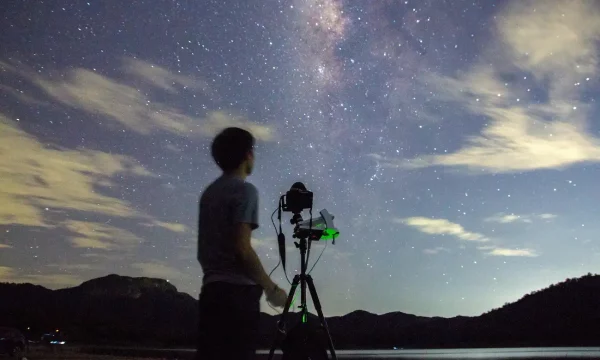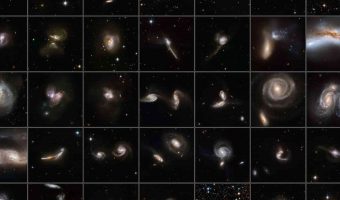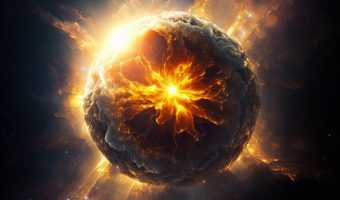
This amateur astronomer discovered a brand-new nebulae never seen before
Last Updated: February 20, 2023
Amateur astronomer, Bray Falls, has accomplished a remarkable feat by discovering a new nebula in the milky way galaxy located in the constellation Monoceros. Dubbed “Fal1 – The Kyber Crystal Nebula”, this mysterious and low surface brightness object is believed to be similar in nature to the Squid Nebula.
Bray’s discovery is a testament to the power of human curiosity and the incredible discoveries that can be made through dedicated exploration and investigation. Read on to learn more about this groundbreaking discovery and the journey of this astrophotographer.
Meet Bray Falls, astrophotographer extraordinaire
Bray Falls is an astrophotographer from phoenix, Arizona who takes stunning images of the night sky. He became interested in astronomy at a young age. He started with visual observing but later shifted his focus to astrophotography to capture more detail and share his stunning images with others.
With half a million followers on Instagram and almost 50k subscribers to his Youtube channel, it is safe to say that Bray has built a significant online following and has a large platform to share his content and message with a wide audience.
He is known for his patience and resilience in the pursuit of capturing the perfect image and his ability to capture a wide range of celestial wonders, including nebulae, galaxies, and constellations.
In addition to his social media presence, Bray also maintains a website where he sells his stunning photographs online, providing fans and art enthusiasts alike with the opportunity to own a piece of his unique and captivating vision.
To find the Kyber Crystal Nebula, Bray used a telescope setup that he has permanently parked in a remote telescope-hosting facility called “Sierra Remote Observatories“. The SRO allows astrophotographers to safely leave their telescope in secure facilities located in very dark sky areas. Astrophotographers can then remotely control their telescope from the comfort of their home and enjoy a light-pollution-free zone.
According to his astrobin page, below is the complete set-up he used to photograph this newly found celestial object.
- Imaging Telescopes Or Lenses: Takahashi FSQ-106ED
- Imaging Cameras: QHYCCD QHY600L
- Mounts: Software Bisque Paramount MYT GEM
- Filters: Chroma Blue 2″ · Chroma Green 2″ · Chroma H-alpha 5nm Bandpass 2″ · Chroma OIII 3nm Bandpass 2″ · Chroma Red 2″ · Chroma SII 5nm Bandpass 2″
- Accessories: Takahashi Reducer-QE 0.73X (TKA36580)
Meet Fal1 - The Kyber Crystal Nebula
Speaking in a YouTube video, Bray said that Fal1 is “a very faint, low surface brightness primarily O3 nebula” located in the Monoceros constellation between the seagull nebula and the rosette nebula. He also noted that there is a star in the middle of the nebula which is likely the source of its ionization.
In the comment section, Bray provided the celestial coordinate for other astronomers to take a look at his discovery: 06:58:50.2748670 -06:33:32.792498.
Right ascension is measured in hours, minutes, and seconds, and is used to specify an object’s position in the east-west direction of the celestial sphere. The right ascension coordinate ranges from 0 to 24 hours, with 1 hour equaling 15 degrees of arc.
Declination is measured in degrees, minutes, and seconds, and is used to specify an object’s position in the north-south direction of the celestial sphere. The declination coordinate ranges from -90 to +90 degrees, with 0 degrees being the celestial equator and +90 degrees being the north celestial pole.
In short, the celestial coordinates provide a way to locate objects in the sky, much like latitude and longitude coordinates provide a way to locate places on Earth.
In a Twitter thread, Bray states that his newly discovered celestial object is larger than the moon.
Larger than the moon pic.twitter.com/tWH9lw23iz
— Bray Falls (@astrofalls) February 16, 2023
What he means by that is that the angular size of Fal1 is larger than the angular size of the Moon. The angular size of an object refers to the angle it appears to subtend at a particular point of observation. It is typically measured in units of degrees, arcminutes, or arcseconds, and depends on the physical size of the object and its distance from the observer.
Brays’ discovery is an example of how amateur astrophotographers can make significant contributions to science and continue to discover new objects in space. For example, the angular size of the full moon as seen from Earth is approximately 0.5 degrees, while the angular size of a dime held at arm’s length is about 0.5 degrees as well.
How did Bray discover this never-before-seen cosmic gem
In the video announcing his discovery, Bray describes two ways to find new celestial objects in the night sky:
- Serendipitous discovery: This involves imaging something else that’s well-known and then exploring it in more depth or trying a new filter to see if anything new can be discovered.
- Brute force method: This involves pointing the telescope randomly at different spots in the sky and taking pictures to search for objects that haven’t been photographed before. This method allows amateur astrophotographers to explore regions and wavelengths that haven’t been covered by professional observatories.
Bray was actively seeking new objects in the night sky by pointing his telescope to a random area of the night sky and letting his camera take hours and hours of exposure, which he would then process to look for any previously undiscovered object.
Bray described how he picked the spot where he discovered the nebula: “I was Imaging something else earlier in the evening and later in the evening I was like I have three hours of exposure time to spare for the night. I’m just going to put my telescope somewhere random and I picked like a random spot between the rosette and the seagull and I just started firing away.”
Bray explained that the discovery process required years of learning how to capture deep sky images and thousands of dollars in telescope gear. He noted that while there are websites that claim to let people name stars, those are “totally fake”, and discovering a real object in space takes much more effort.
After many years of photographing the same objects over and over, improving his skill and knowledge in not only photography but also astrophysics, Bray was able to strike gold.
“A lot of the discoveries that amateurs make are typically planetary nebula but this one has been a bit difficult to get confirmed and everything because of its odd nature.
The people I’ve been working with, Pascal Ledu, Marcel Drechsler and Xavier Strottner seem to kind of trend towards the idea that this is likely an ionized interstellar material nebula and not a planetary nebula solely because we couldn’t find a star in the middle that quite suited the narrative of a planetary nebula,” Bray said.
So how does he knows he had found something never seen before? Bray answered this question on a Reddit thread: “The reason I know is through a careful cross-referencing of various space object catalogs, including the HASH PN, CDS, Vizier, and other planetary nebula databases. Following the search I identified a potential CSPN, or center star planetary nebula, a star which could potentially form the nebula. The candidate was then reviewed by a professional astronomer who verified the discovery, and will catalog it officially”
But how do astrophotographers create images of deep-sky objects?
Astrophotographers create images of deep-sky objects by capturing long exposures of light from these objects using specialized cameras and telescopes. They then process the data they capture using software to remove unwanted data, adjust the contrast and color balance of the image, and combine (stacking) multiple images into a final product.
This involves a combination of technical knowledge and artistic skill to balance the need to remove unwanted data with the desire to bring out the beauty and detail of the night sky. The resulting images can reveal stunning details of galaxies, nebulae, and other celestial objects that are not visible to the naked eye.
Some astrophotographers spend just as much time processing their images as they do taking the actual photographs, which can take a few hours. It’s not sufficient to only have expertise in operating a complicated optical and mechanical system to capture images of nebulas. You must also gain proficiency in using various sophisticated software to obtain the intended outcome. After all, collecting good data is only half the battle; knowing how to process it is equally important.
Why is it called the Kyber Crystal Nebula?
When Bray discovered a new nebula, he took to social media to explain why he decided to name it the Kyber Crystal Nebula. According to one of his Instagram posts, the technical name for the object is Fal1, derived from his last name.
However, he also chose to give it a more colloquial name, inspired by the crystal found inside a Jedi’s lightsaber from the Star Wars franchise.
Bray found that the lobes of the outer shell of the nebula resembled terminated crystals, and so he decided to call it the Kyber Crystal Nebula.
While the discovery of the nebula itself happened by chance, Bray’s decision to bestow it with a culturally relevant name was influenced by his girlfriend. This underscores how science can spark the public’s imagination and bring scientific discoveries to a wider audience.
What's next?
Bray reckons the Kyber Crystel Nebula will be analyzed by scientists with a technique called spectrography. Spectrography is a scientific technique used to study the spectrum of light emitted or absorbed by an object, such as a star, galaxy, or nebula. The resulting analysis can reveal important information about the object, such as its temperature, composition, and motion.
Once professional astronomers have spent some time analysing it, the nebula will officially be logged into an official deep sky object.
Conclusion
Bray’s story is a testament to the power of curiosity and determination in the pursuit of knowledge. Discovering a new nebula from a backyard is such an incredible feat. And it seems that it is becoming a more regular occurrence lately.
Just last month, a long filamentary [O iii] emission nebulosity located near the Andromeda galaxy was officially discovered by french astroimager Yann Sainty.
We want to express our sincere admiration and gratitude to the countless amateur astrophotographers around the world who devote countless hours to capturing photons that have traveled light-years to reach their telescopes.
You are the true stars, and here at Starlust, we celebrate your accomplishments and the passion and dedication that drive you to explore the wonders of the universe. Thank you for inspiring us all!
You can follow Bray’s cosmic adventures via social media and YouTube:

I’ve been fascinated by space and astronomy from a very young age. When I’m not watching space-themed documentaries, movies or TV series, I spend most of my free time in my backyard admiring the planets and galaxies with my telescope.
Wow! There's more to read 🚀
This page is part of our collection of articles about astronomy. If you enjoyed the read, then you’ll love the following articles.




